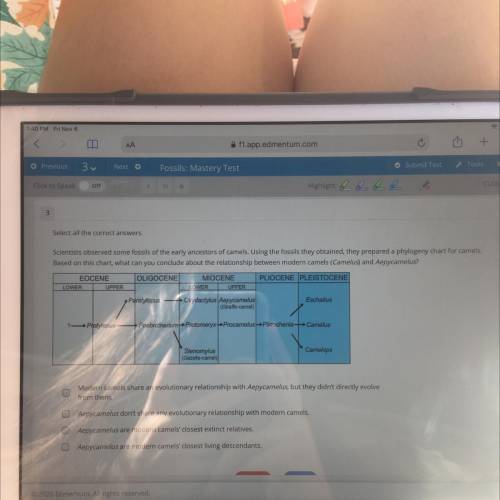
Biology, 06.11.2020 22:00 dorindaramirez0531
65 POINTS!
Scientists observed some fossils of the early ancestors of camels. Using the fossils they obtained, they prepared a phylogeny chart for camels.
Based on this chart, what can you conclude about the relationship between modern camels (Camelus) and Aepycamelus?
OLIGOCENE
PLIOCENE PLEISTOCENE
EOCENE
LOWER UPPER
MIOCENE
LOWER UPPER
Paratylopus
Eschatius
Oxydactylus Aepycamelus
(Giraffe-camel)
7-Piptylopus
Poebrotherium - Protomeryx-Procamelus-Pliauchenia-C amelus
Camelops
Stenomylus
(Gazele-camel)
Modern camels share an evolutionary relationship with Aepycamelus, but they didn't directly evolve
from them.
Aepycamelus don't share any evolutionar relationship with modern camels.
Aepycamelus are modern camels' closest extinct relatives.
Aepycamelus are modern camels' closest living descendants.


Answers: 2


Another question on Biology

Biology, 21.06.2019 21:30
Which best explains why there are 64 possible codons in the genetic code and only 20 amino acids that make protiens of living organisms on earth
Answers: 3

Biology, 22.06.2019 03:00
Where does all the water go? according to the environmental protection agency (epa), in a typical wetland environment, 39% of the water is outflow; 46% is seepage; 7% evaporates; and 8% remains as water volume in the ecosystem (reference: united states environmental protection agency case studies report 832-r-93-005). chloride compounds as residuals from residential areas are a problem for wetlands. suppose that in a particular wetland environment the following concentrations (mg/l) of chloride compounds were found: outflow, 60.4; seepage, 73.7; remaining due to evaporation, 26.4; in the water volume, 46.8. (a) compute the weighted average of chlorine compound concentration (mg/l) for this ecological system. (round your answer to one decimal place.) mg/l (b) suppose the epa has established an average chlorine compound concentration target of no more than 58 mg/l. does this wetlands system meet the target standard for chlorine compound concentration? yes. the average chlorine compound concentration (mg/l) is too high. yes. the average chlorine compound concentration (mg/l) is lower than the target. no. the average chlorine compound concentration (mg/l) is lower than the target. no. the average chlorine compound concentration (mg/l) is too high.
Answers: 3

Biology, 22.06.2019 05:30
Plants consume most of their carbon from a. the soil b. the water c. the roots d. the air
Answers: 2

Biology, 22.06.2019 08:30
Gene expression is the activation of a gent that results in a question 1 options: protein dna mitochondria
Answers: 1
You know the right answer?
65 POINTS!
Scientists observed some fossils of the early ancestors of camels. Using the fossils the...
Questions

Arts, 10.09.2020 01:01




Mathematics, 10.09.2020 01:01

Physics, 10.09.2020 01:01

Biology, 10.09.2020 01:01



History, 10.09.2020 01:01

Computers and Technology, 10.09.2020 01:01


Mathematics, 10.09.2020 01:01


English, 10.09.2020 01:01



Chemistry, 10.09.2020 01:01

Mathematics, 10.09.2020 01:01

History, 10.09.2020 01:01



